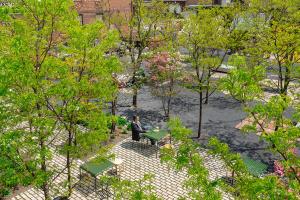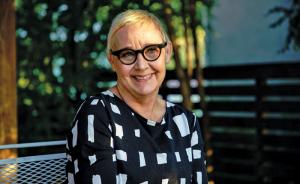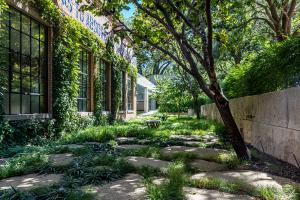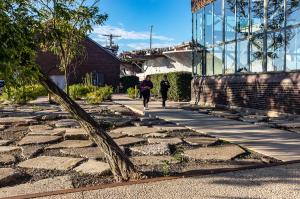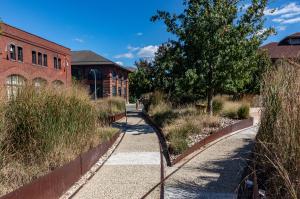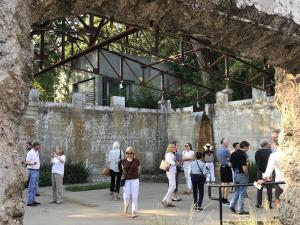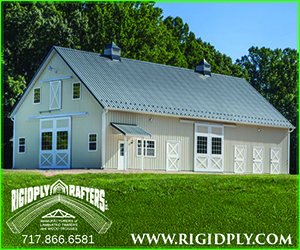Compiled by Nancy Brannon; photos courtesy The Cultural Landscape Foundation
Professor Julie Bargmann is providing a valuable service to communities and the Earth, and she was recognized for her efforts as the inaugural winner of the Cornelia Hahn Oberlander International Landscape Architecture Prize, announced in October 2021 by the Cultural Landscape Foundation. The biennial Oberlander Prize, which includes a $100,000 award, two years of public engagement activities focused on the laureate’s work and, more broadly, landscape architecture, is named for the late landscape architect Cornelia Hahn Oberlander. The award is bestowed on a recipient who is “exceptionally talented, creative, courageous, and visionary” and has “a significant body of built work that exemplifies the art of landscape architecture,” according to the Cultural Landscape Foundation. Bargmann, an innovative architectural designer, has been lovingly referred to as “the toxic beauty queen of brownfield remediation.”
Bargmann is Professor of Landscape Architecture at the University of Virginia and founder of a studio called D.I.R.T – Dump It Right There. Rather than designing gardens for stately manors, Bargmann tackles toxic dumps, Superfund sites, and wastelands that she cheerfully describes as “gnarly.” For more than thirty years as a teacher and a landscape architect, Bargmann has principally focused on contaminated, neglected, and forgotten urban and post-industrial sites. “Both the pedagogy of my teaching and my methodology as a designer address the social and ecological imperatives to reclaim degraded land. Integrating regenerative technologies with design propositions and built landscapes embodies my contribution to the discipline of landscape architecture,” said Bargmann.
In an interview with NPR’s Neda Ulaby Bargmann explained: “I had a raw, kind of instinctual attraction to landscapes that literally no landscape architects were paying attention to.” She has redesigned abandoned rail yards, quarries, landfills, derelict factories, and coal mines. In Detroit, she redeveloped an urban woodland around an apartment complex using Quonset huts in patterns inspired by the sheet music for John Coltrane’s “A Love Supreme.”
Maurice Cox, former head of Detroit’s Department of Planning and Development, told NPR: “Julie holds a classic notion that all sites have a history. She had the developer get a backhoe and start digging in the dirt, only to uncover the foundations of a farmhouse that once resided on that lot. And she scraped and scraped and used the foundation of that former farmhouse as the makings of the park, and went in and planted dozens and dozens of trees. And a whole urban place was created. And Julie would tell you that it was already there. All she had to do was unearth it.”
Cox describes Bargmann as a visionary thinker whose life work revolves around finding existing beauty in marginal communities that respects and honors those places.
Bargmann says while she’ll continue reclaiming individual sites, she’s increasingly drawn to larger canvases. “Namely, post-industrial cities and regions,” she said. “There exists massive potential and sublime beauty in places that may seem, at first blush, to be trashed. Sites, neighborhoods, entire cities — they are full of energy waiting to be recognized, released, and given new form.”
Read more about Bargmann and her reclamation projects at: https://tclf.org/julie-bargmann-wins-inaugural-cornelia-hahn-oberlander-international-landscape-architecture-prize. Find more information about landscapes designed by Julie Bargmann at: https://tclf.org/three-landscapes-designed-julie-bargmann-inaugural-oberlander-prize-laureate
Additional Sources:
https://www.npr.org/transcripts/1045598031
https://www.npr.org/2021/10/14/1045598031/landscape-architecture-julie-bargmann-oberlander-prize
Visit DIRT Studio: https://www.dirtstudio.com
Article (2003) on Julie Bargmann: https://metropolismag.com/programs/industrial-strength/
Graves, Lee. “Queen of Slag.” UVA Magazine. https://uvamagazine.org/articles/queen_of_slag
The Cultural Landscape Foundation: https://tclf.org
For information about the Oberlander International Landscape Architecture Prize, please visit: https://tclf.org/prize
